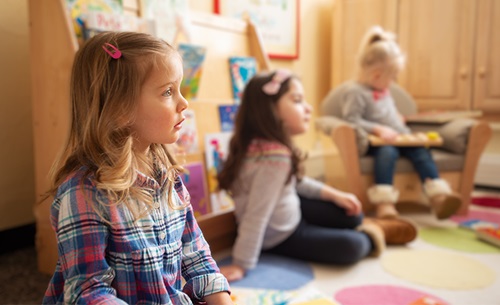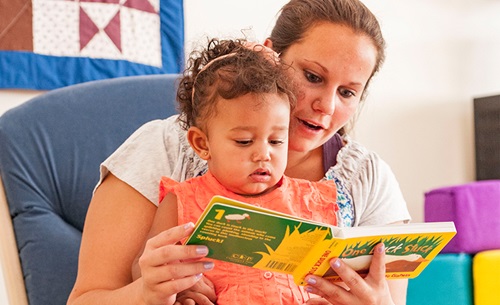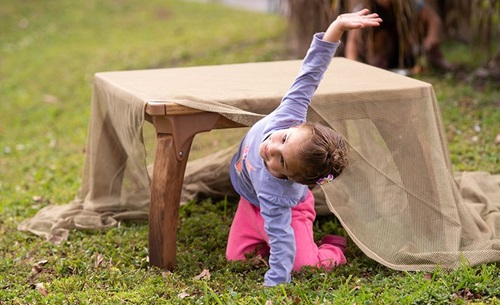Helping Children Cope with Separation
| May 2011There are many ways to help children express their feelings about separation and cope with their emotions. The key to working with young children and babies as they enter early care and education is to communicate that it is OK to feel sad, frightened, or angry. In legitimizing these feelings, you build self-confidence and trust. This is just the opposite of conventional wisdom that dictates “don’t talk about it.”
If young children are worried about where their parents are, or worried about feeling angry, they will not be able to use their energy for the normal pursuits of learning and exploration. In trying to distract children or otherwise minimize their anxious feelings, you send a message that their emotions are not authentic. However, when you validate these emotions, you contribute to a child’s sense of power. In successfully contending with a difficult situation, children learn that adults are reliable.
Encouraging expressions of emotion, through both words and actions, is an investment in children’s growth. In the words of one expert, “The child who really copes well allows himself to miss the absent loved one, to feel sad, lonely and perhaps angry, and to express his feelings appropriately” (Furman, 1974, p. 16).
What are some special strategies that are useful for giving children comfort during these first few weeks and help them move toward self-confidence?
- Encourage children to participate fully in saying goodbye. Hugging, kissing, crying, waving, and saying, “I’ll miss you” are all ways of bringing feelings out into the open. Once in the open, they are easier to deal with. A parent should never sneak out.
- Plan together—parents, teachers, and children—for the next day’s parting. Will the child walk with the parent to the door? Make a drawing for the parent to take along? Will the parent read one story? Through such planning children gain security and experience self-confidence.
- Provide an opportunity for children to watch parents leave. Teachers and parents can choose a window in the classroom through which children can peer. Steps placed by a high window allow children to look into the street as parents leave the building, look up, and wave goodbye.
- Regard all the “baby ways” that may appear, from thumb-sucking to wet pants, without a fuss. The less attention you pay to such behaviors, even if you do not like them, the sooner they will disappear.
- Be aware of transition times in the daily classroom schedule, such as cleanup periods or moving from one activity to another. Sometimes those “in-between times” are especially difficult for children who are coping with separation. They may go out of control, hit other children, withdraw, suck their thumbs, or masturbate. Try to involve a child in activity right away.
- Recognize that Mondays and Fridays are often hard days because they involve parting from parents (Monday) and from the center/school (Friday). And don’t forget the day after (or before) a holiday break.
- Encourage children to bring a favorite toy or blanket to school each day, or something belonging to their parents. Allow them not to share these “security” objects. To the children, they are a bit of home.
A reminder to caregivers of infants and toddlers—when leaving the room to go to the bathroom, getting more supplies from the closet in the hall, or taking a regular break, be sure to announce, “I’ll be right back.” Children under three often equate an adult leaving the room with the departure of their own parent.
ACTIVITIES THAT SUPPORT CHILDREN
Specific activities can engage young children’s coping abilities and help them realize that while home and program are separate, home is not forgotten.
Creating Wall Displays
A list of children’s names and birthdays on a kindergarten or preschool wall chart will attract the attention of children and their parents. What a sure message to children that the teacher really wants them! If the names are printed large, with a felt-tip marker, children who are able to recognize their own names will feel pleased. Children who do not read will feel equally delighted when their parents point out their names.
Writing Letters
Writing a letter to the parent from the child is meaningful to 3-, 4-, and 5-year-olds. Setting down “Come back soon,” “I miss you,” or “I love you” in words on paper seems to be very reassuring. The letter can contain a drawing or the child’s own “writing” and can be tucked away in the child’s cubby to be shared, or not, when the parent comes back. It will be up to the child to decide.
Displaying Photographs
Photographs of children’s families, including pets, posted in an accessible spot help young children remember that their families really do exist, even though they cannot be seen. If these photographs are covered with clear adhering plastic, they will withstand lots of loving attention. Be sure they are hung at children’s eye level so that they can be seen easily. If they are attached to a board with velcro, the children can take them off and carry them around as needed.
A teacher of toddlers gathers the children together each morning for a short circle time. She holds up a photo of one child at a time, asking, “Who is this?” Some children call out the name, especially the picture child who then takes the photo and presses it to the velcro on a large board. They sing, “Good morning to Jody, good morning to you….” And go on to the next photo.
A special book of photographs about life at home may help ease the transition from home to program and provide an opportunity for parents to be involved. A child could take the book home each afternoon and bring it back in the morning.
A picture of the family tucked into a child’s lunch box brings a warm reminder of home.
Cooking
Cooking activities link young children to home in a very concrete fashion. Nothing could be more familiar than food and its preparation, except its consumption. Cooking with children is a natural way to bring home and school together while at the same time creating opportunities for competent action and intellectual investigations. Shaping the cookies, mixing the batter, cutting vegetables for soup, dipping bread into an egg-milk mixture for French toast, and peeling then slicing a banana with a tongue depressor are all activities that allow even the youngest children to share the enticing world of adults. Here also are chances for mind stretching—reading recipes, calculating quantities, measuring, predicting outcomes (e.g., What will happen to the flour when we add the milk?), and engaging the senses. Powerful connections with home are forged when a family member actually comes into the classroom to help a cooking group or to teach them how to create a special dish.
Playing
Both teachers and parents need to provide for, and observe, the natural make-believe play of 1- to 5-year old children. This will give consistent clues as to how children are doing in their attempts to cope with separation reactions. Children may play baby or nurturing parent many times over in their attempts to come to terms with their feelings. They may play themes of moving or going away on a train, car, or a plane. They may play monster as they begin to face their fears of being on their own in school or center. Provide for this play by supplying props such as cast-off telephones, suitcases, steering wheels, dolls, a doll bed large enough for a child to lie in, and, most important, time, space, and privacy for play. By listening to and observing such play, you will discover the means children use to cope with their feelings and their thoughts.
A teacher can read a story to some preschool-age children, such as Amos and Boris (Steig, 1971), which is about the parting of two dear animal friends. Then an environment can be created for them to act it out on their own terms as described by Vivian Paley (2004). The children will assign roles to one another and decide among themselves how the story will be played. It will be their interpretation, not a re-creation of what was just read.
Another form of make-believe that is meaningful to preschoolers of ages 3, 4, and 5 is puppet play. Using puppets may help children express their feelings of longing for their parents. Children this age are attracted by soft animal puppets and can project themselves into the puppet. Often they label the puppet “mommy,” “daddy,” “grandma,” or “baby.” Adults can help children by using a puppet to ask their puppets questions, such as, Do you go to school? What do you play with when you are at school? When you are at the center, what is your mommy (daddy, grandma) doing? Do you have a baby in your house? Who takes care of your baby? Adults may be included in the play and perhaps assigned a role. (Remember that although toddlers are very attracted to puppets, it is beyond their developmental capacity to project themselves into the puppet for this form of play.)
Even so humble a game as ball play can serve to soothe a child’s separation emotion. Not only a preschooler or toddler, but also a baby who is now able to sit steadily, can get emotional profit from rolling a ball back and forth with an adult. This social play clearly represents the “goodbye” and “hello” of parental departure. Using those very words as you play this game will make that association available to the child.
And don’t forget the old-fashioned jack-in-the-box toy to act out “you’re gone, you’re back!” with all the excitement of waiting for the music to end and the jack to jump up!
Games of peek-a-boo, covering your face (or the toddler’s face) with a cloth, and games of hiding and retrieval can be played in sand and water where small toys can be hidden and found easily. Hide-and-seek, chase, “gonna get’cha” are more active forms of the same game. These are all ways of practicing, recapitulating, and getting a grip on being left and being reunited. Such games give children control over the process of leaving and returning. Don’t underestimate the power of peek-a-boo for young children. It’s not only a game for babies.
Providing Expressive Materials
Provide non-structured materials such as paints, blocks, clay, crayons, felt-tip markers, and clean drawing paper. This allows children to spontaneously represent their feelings about themselves, their families, and their entry into the new world of school. Some of those feelings may not be pleasant, and it will help if you are prepared to see both angry and sad feelings being displayed.
Reading Books
Storybooks about how it feels to be separated from a loved one can open the way for children and adults to talk together about separation and to gain new insights into the process.
Choosing these books should be done with care. The first consideration is that the book be good literature. It should be pleasurable to read and pleasurable to hear. Does the book display clarity of writing style, brevity, interesting characters, and suitable illustrations? Is the story related to the child’s own life experiences? Do children see people like themselves? Is the book in their language? Be certain that the book is free from stereotypes. It must also appeal to adults—it is very unsatisfying to read to children if the book is uninteresting to the reader.
How you read a book to children is critical. First, be thoroughly familiar with the book before you read it to a child. Next, introduce it briefly by referring to a naturally occurring situation that may have prompted its use. Asking specific questions throughout, or after, the story “encourages children to analyze the behavior of the story characters, make inferences about emotional reactions, apply information to their own experience, and synthesize techniques for coping with crisis”. Finally, summarize the story by rephrasing the basic story concepts. In this way, children’s ideas and information can be clarified.
Used with permission from the Publisher. From Balaban, Everyday Goodbyes:
Starting School and Early Care---A Guide to the Separation Process, New York:
Teachers College Press, © 2006 by Teachers College, Columbia University.
All rights reserved. To order copies visit www.tcpress.com or call (800) 575-6566.







